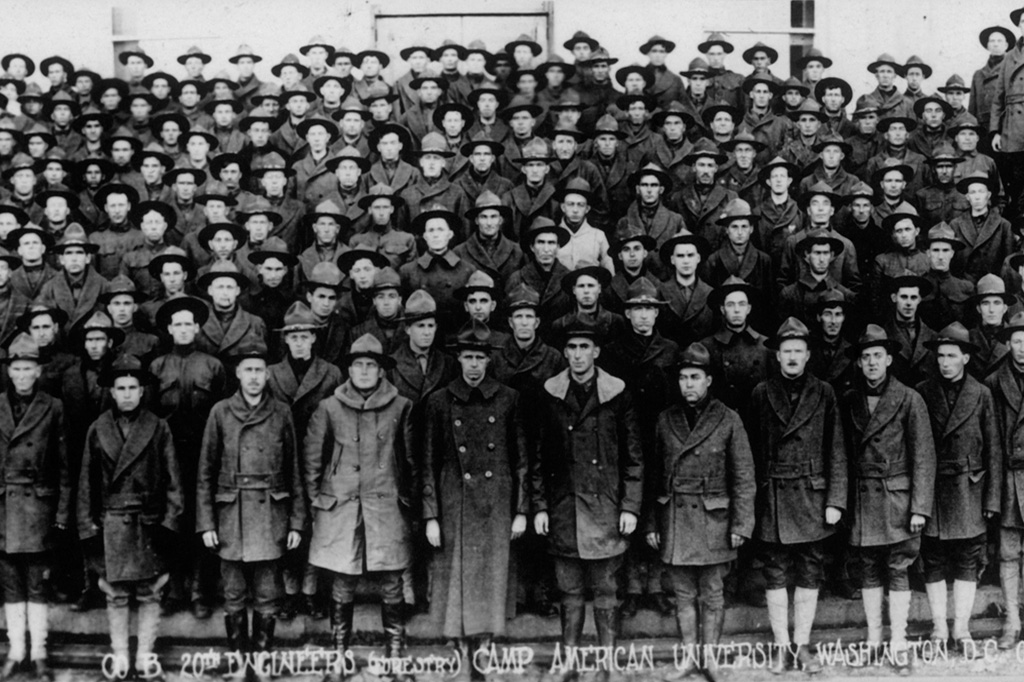Mustard gas, aerial bombings, and death from disease and the influenza epidemic were all part of the horrors of World War I. Despite those prospects, and perhaps forgotten or unknown to many living today, over 100 men from Idaho enlisted in the 20th Engineers (Forestry) Battalion, the largest American regiment in WWI. These uniquely qualified soldiers were considered lucky in that they served behind the front lines, but they worked around the clock, seven days a week, to supply the troops with lumber for hospitals, trenches, bridges, railroad ties, stakes for entanglement fences, and constructing buildings that supported the war effort.
On April 6, 1917, Congress passed President Woodrow Wilson’s declaration of war against Germany. The U.S. joined the Allies, which included Great Britain, France, Russia and, by the end of the war, Italy. The Allies fought against the Central Powers, the nations and regions of Germany, the Austrian-Hungarian Empire, the Ottoman Empire, and Bulgaria.
A Plea for Help
Upon the United States entering WWI, urgent pleas from the French and British were made to the American Expeditionary Forces (AEF) Commander Gen. John Pershing to send foresters and lumbermen to aid the war effort. One historical account states that our allies asked Gen. Pershing to send foresters before sending soldiers. The U.S. War Department made it a top priority to seek skilled forestry troops to serve in the Army.
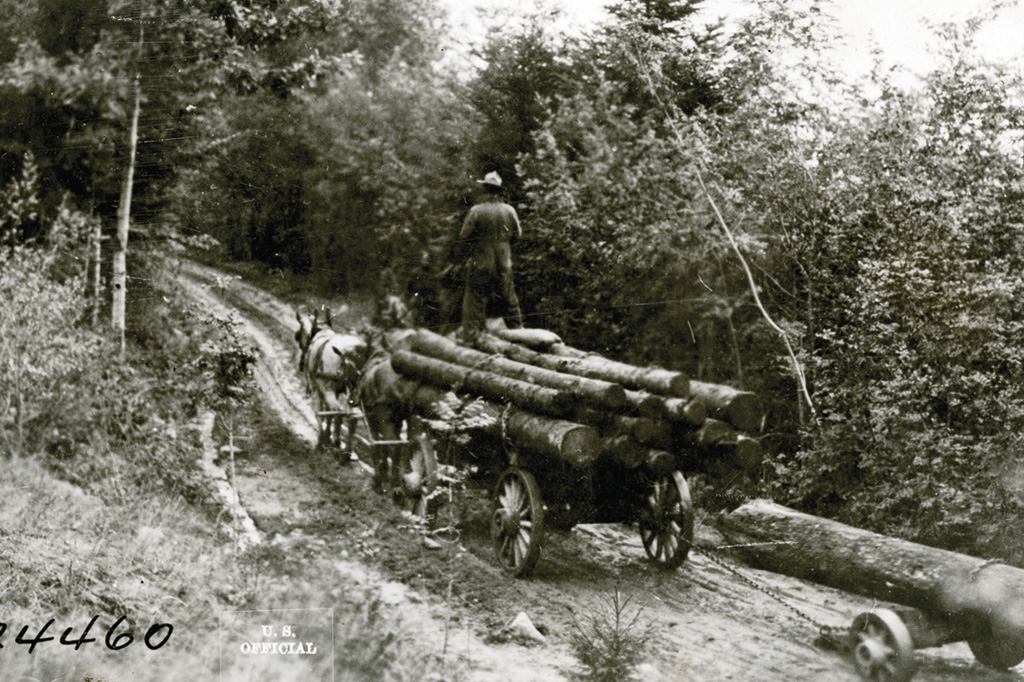
A forestry soldier hauling lumber during the war in rural France. Photo courtesy U.S. Army Heritage and Education Center
The 10th Reserve Engineers (Forestry) was formed in May 1917 to recruit soldiers with forestry skills to produce lumber for American and Allied military operations. Recruiting ads boasted: “Join the Largest Regiment in the World.”
The U.S. Forest Service, with assistance from state foresters and lumber associations, recruited men to serve in the 10th Engineers. On Aug. 15, 1917, all forestry units merged under the 20th Engineers (Forestry) with Col. James A. Woodruff named commanding officer.
The 20th Engineers had 514 officers and 30,145 enlisted men from every state in the nation. By the end of December 1917, Idaho had provided about 110 men to the 20th. Col. William Greeley was in charge of recruiting for the regiment. Prior to joining the Army, Greeley had worked for the U.S. Forest Service as the district forester for Northern Idaho and Western Montana and, consequently, he recruited men he had worked with from Idaho.
Basic training for the soldiers was held on the American University campus in Washington, D.C. The soldiers participated in military drills and were taught administrative and disciplinary procedures before being shipped to France. The troops were already skilled woodsmen and did not require further training for the jobs they would perform. However, when the American Forestry soldiers first arrived in France, in the fall of 1917, they had to first build the sawmills they would later use in the war effort. The sawmills were built with tools and equipment provided by the U.S. government, though some equipment and tools were lacking. Soldiers improvised as best they could with the available odds and ends.
Once the men arrived in France they were assigned to work either in one of the 81 mills that produced 2 million board feet of lumber every day or at regimental headquarters in Tours.
The forestry regiment cut 272.5 million feet of lumber and 2.73 million railroad ties by Dec. 1, 1918. Most of the soldiers’ military equipment was left behind at supply stations, and it was estimated only one-tenth of the guns issued were taken to the lumber camps.
One Idaho Soldier’s Story
Idaho resident Willis C. “Buck” Brassey enlisted in the United States Army on Oct. 3, 1917, at age 23. Prior to joining the Army, Brassey operated an automobile transport business and owned a seven-passenger Cadillac that he used to transport residents and gold bullion from Placerville and Idaho City to Boise. From the day Brassey began his service in the American Expeditionary Forces he saved transfer orders, photographs, letters, and memorabilia that documented his war experience.
This collection, preserved in a scrapbook, along with Brassey’s oral history in the Idaho State Archives, provides a glimpse into the life of a WWI forestry soldier. Letters from fellow soldiers serving in the Army suggest the deep camaraderie that developed among them. Photographs and letters from family, friends, and spouses kept the soldiers abreast of the latest news and encouraged soldiers to fight for their loved ones, yet also made the soldiers long for home. Sickness, fires, and deaths reminded soldiers of the loss and heartache that was also occurring in their hometowns.
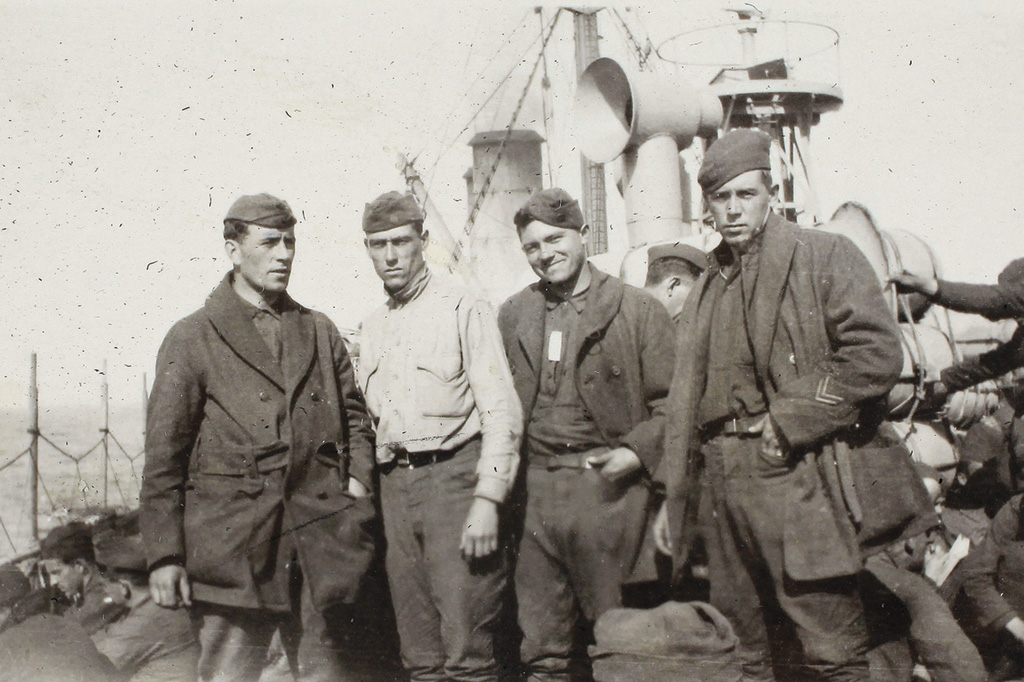
Soldiers on board the USS Madawaska. Courtesy Brassey Family Collection
Pvt. Brassey enlisted as a Wagoner and was assigned to the 1st Battalion, Company B, later known as the 30th Co., 20th Engineers (Forestry). This battalion had a remarkably diverse roster of men; they came from nearly every state in the nation. The battalion sailed for France on Nov. 11, 1917, arriving at the port of St. Nazaire on Nov. 28 on the USS
Madawaska. The ship was originally owned by Germany under the name
Koenig Wilhelm II.
In November 2017, Emile Grandjean, Boise National Forest Service supervisor, wrote in response to a letter from Pvt. Brassey, dated Oct. 27, 2017:
I was surely glad to receive your letter of October 27, and to know that you and all the boys from Idaho are getting along nicely. Yes, I feel sure that you like Washington, though it is really more of a great big overgrown village than a real city. I suppose you have visited all the different Government institutions, especially the Smithsonian and the Library … since you left the enlistment for the Regiment has been extremely slow. It appears that we have practically obtained all the men of experience who are willing to enlist in this part of Idaho…
Upon arriving in France, Pvt. Brassey was assigned the job of checking in U.S. equipment at regimental headquarters in Tours, France. Soldiers needed saws, axes, and large equipment for the sawmills. According to Pvt. Brassey, $300 million worth of equipment was shipped to France from the U.S. Fearing the Germans would sink many of the transport ships, the U.S. shipped much more equipment than was needed for the forestry regiment. As it turned out, none of these ships was sunk, and all the equipment remained after the Armistice, leaving all 81 sawmills in operation in France.
Working Behind the Front Lines
Soldiers in the 20th Engineers worked long, monotonous hours as they served in Services of Supply (SOS) behind the front lines. Company B, 1st Battalion forestry soldiers enjoyed privileges that most other forestry companies did not receive, like Army regulation leave, dances that local young French women attended, and a company band.
Great risk was involved in transporting troops to France because German U-Boats sank on average 60 boats per week. The largest loss of life of the 20th Engineers occurred on Feb. 5, 1918; 95 men died when the S.S. Tuscania, transporting forestry troops to France, was sunk by the Germans. Many of the men died when their lifeboat drifted to Scotland and crashed into the rocks at the Isle of Islay. No Idaho soldiers were lost on the S.S. Tuscania. While Fred Groomer from Horseshoe Bend was feared to have drowned, it was later discovered he had disembarked from the ship at Halifax, where he was quarantined with the measles.
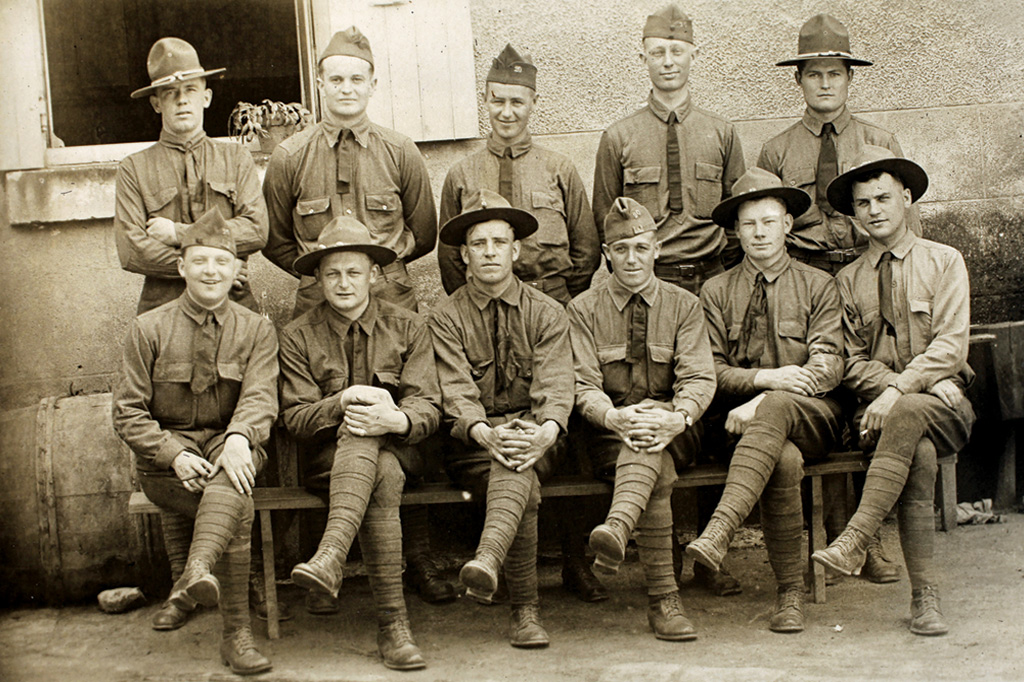
Pvt. Brassey poses with WWI soldiers (back row, far right). Courtesy Brassey Family Collection
Frontline soldiers fighting in the trenches often looked down on SOS soldiers because they felt these soldiers lived entitled lives of being well-fed and away from the life-and-death dangers of combat. Forestry soldiers were also called POGs, People Other Than Grunts, and SOL, Shit Out of Luck. A popular song was created by the 20th Engineers soldiers assigned to headquarters in Tours.
Mother, Take Down Your Service Flag,
Your Son’s in the SOS
He’s SOL, but what the hell,
He never suffered less.
He may be thin, but that’s from gin,
Or else I missed my guess.
Mother, Take Down Your Service Flag,
Your Son’s in the SOS
Even though fewer SOS soldiers died than combat soldiers, there were still deaths from accidents, disease, and ships sunk by the enemy. The book “Twentieth Engineers: France 1917-1918-1919” states, “It is altogether probable that 375 men of the regiment lost their lives in service of our country.”
Letters to Soldiers
Letters were the most treasured form of communication between soldiers and their loved ones at home. Soldiers also wrote to friends serving in different locations in France. Pvt. Brassey’s friend Lawrence wrote to him on Oct. 24, 1918, expressing his desire to leave the SOS and join the artillery troops.
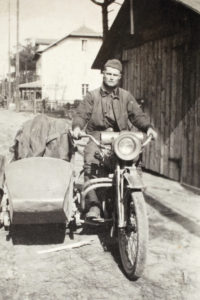
In spring 1918, Pvt. Brassey was assigned to drive Maj. F. M. Bartelme, Cmdr., 14th Battalion,
20th Engineers, who ran the sawmill in LePuy, France. Courtesy Brassey Family Collection
Dear Friend Buck,
I received your letter of Sept. 20th and was very glad to hear from you old man for I couldn’t figure out what had become of you.
Glad you are driving old boy for you will get to see a great deal of France and it is right in your line to. We are as busy as hell around here now and have a bit of excitement to(o). Yesterday we saw quite an air Battle five Huns and six allies and what I mean for a few minutes it was a real game of tag. don’t know how they came out for in a few minutes they were all out of sight. I think that I have a chance to get transferred into the Artillery and I’m sure trying hard to make it. I will be glad to have a chance of pouring hot lead at the Huns for a change instead of having them cut loose at us and not be able to shoot back at them …
Write when you have time. Good luck and best wishes old pal and here’s hoping that we see each other in the states soon.
Yours,
Lawrence
Such letters and packages from home were highly prized and helped soldiers feel connected to their friends and family.
Entertainment in the Army
During the war years, poetry was highly esteemed among soldiers and the general public. The written word, poetry and songs had a much more important meaning to soldiers in an age without radio, television and instant communication. Soldiers and loved ones memorized poetry, invented songs for their amusement, and wrote daily letters to family and friends.
- P. McEvoy illustrated this in “The Flu” from his collection of humorous poems, “The Slams of Life.”
THE FLU
When your back is broke and your eyes are blurred,
And your shin bones knock and your tongue is furred,
And your tonsils speak and your hair gets dry,
And your doggone sure that you’re going to die,
But you’re skeered you won’t and afraid you will,
Just drag to bed and have your chill,
And pray the Lord to see you through,
For you’ve got the Flu, boy,
You’ve got the Flu.
When your toes curl up and your belt goes flat,
And you’re twice as mean as a Thomas cat,
And life is a long and dismal curse,
And your food all tastes like a hard-boiled hearse,
When your lattice aches and your head’s a buzz,
And nothing is at it ever was,
Here are my sad regrets to you—
You’ve got the Flu, boy,
You’ve got the Flu.
What is it like, this Spanish Flu?
Ask me, brother, for I’ve been through.
It is by Misery out of Despair;
It pulls your teeth and curls your hair;
It thins your blood and brays your bones,
And fills your craw with moans and groans,
And sometimes, maybe, you get well.
Some call it Flu—I call it hell!
In addition to enjoying poetry and letters from home, soldiers could get a respite from the war through the services of the YMCA. The YMCA set up canteens for the soldiers during WWI and provided entertainment and reading material, some of which related to the morale, welfare, and rest and recreation for soldiers. Later the YMCA created the USO that entertained soldiers during the Second World War.
A Deadly War Ends
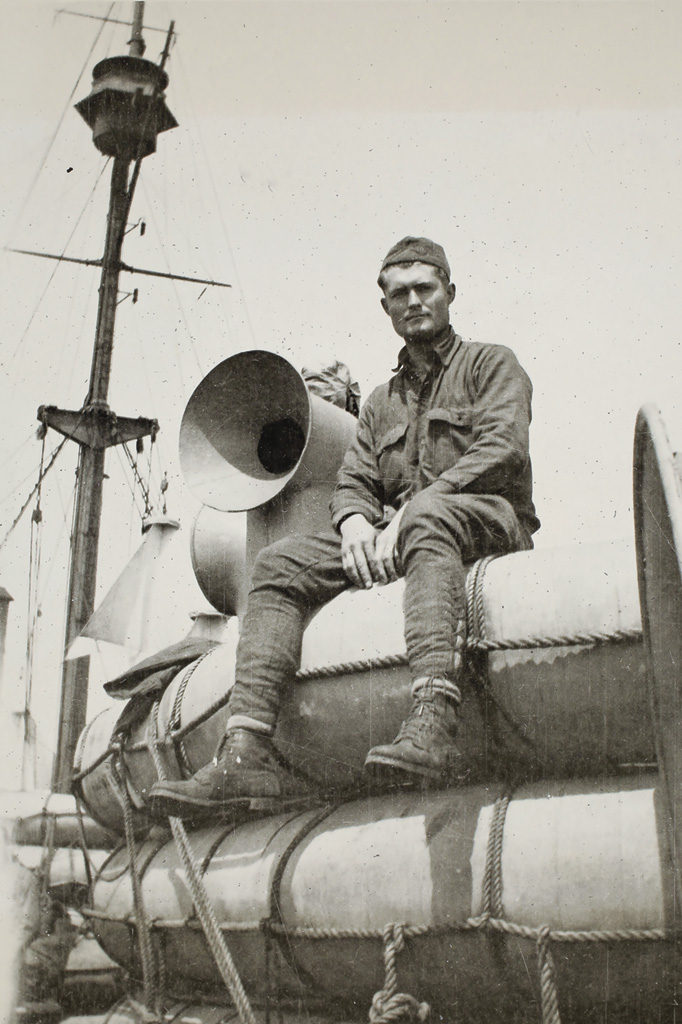
WWI soldier Pvt. Willis Brassey
returned home in May 1919 on the USS Missouri and brought back memorabilia, including poems, songs and photographs of friends he served with in WWI. Photo courtesy Brassey Family Collection
The war ended with the signing of the Armistice on Nov. 11, 1918. Once the Armistice was signed, there were not enough ships to immediately return all the soldiers to the U.S. Many soldiers stayed in France and were assigned to road repairs. Pvt. Martin Smith wrote to Pvt. Brassey relaying news from home and longing to see a familiar face.
December 23, 1918
Brest, France
Dear Buck,
Some weather we are having in this burg, rain all the time and mud, but I guess I can’t tell you anything about France.
I left the old U.S. three months ago myself. The time passed away fast when a fellow works every day. We landed in this port and been here ever since driving the trucks around the docks and camps. At present I am driving one of those English Karriers. I change shifts today and go on nights. A fellow has got to have eyes like a cat to see without lights.
Are you still driving a truck? Say, old boy when you start home you’ll more than likely come here to embark and if you
do be sure and look up the fighting 548 Motor Truck Co. We will get on a drunk to celebrate the occasion. A fellows eyes get sore watching for a familiar face.
They had quite a time at home with the Spanish “Flue” but thank God, old boy, none of our loved ones got caught.
I suppose you heard about Mrs. McDevitt passing away so suddenly. It must have been heart trouble.
These French “dames” are sure classy but give me a good old American girl any day. What do you say?
Everyone was fine at home when I last heard mother and dad had just got over a light touch of the flu. Little Buck was getting along fine.
Well old sport I’ll close for this time wishing you a Merry Xmas and a Happy New Year and may the next one see us both back in old Placerville.
With best regards
from your best friend Lloyd
(Pvt. Martin L. Smith)
A detachment order was issued by 1st Lt. Raymond Davis, AEF Headquarters, 14th Battalion, 20th Engineers, USA.
The Detachment Order, Number 17, was written on the final day of WWI. The order declared, “The above is to provide an opportunity for the men of these headquarters to mingle with the civil populace, that they may celebrate with them the triumphant ending of the Greatest War in all times.”
Col. J.A. Woodruff, Commanding Officer of the 20th Engineer soldiers also wrote to his soldiers at the end of the war. “Notwithstanding the difficulties in obtaining equipment and transportation, notwithstanding the enormous increase in the size of the American E.F., and the work which it undertook over the original estimates, the Army has been given the lumber which it needed, and the suspension of hostilities finds us with a substantial surplus which will be used for the restoration of France … Time and again in spite of difficulties such as lumbermen never contended with before, you have exceeded our expectations. Your record as members of the American E.F. will be a source of pride and satisfaction as you return to civil life.”
WWI Exhibit
The exhibit “WWI Idaho Forestry Soldiers: Call to Action” is open at the J. Curtis Earl Museum located on the Old Penitentiary grounds. The exhibit features artifacts from WWI and photographs taken during WWI. This museum is part of the Idaho State Historical Society.
In addition to visiting the WWI Idaho Forestry Soldiers exhibit, you can walk through a WWI trench, aim a machine gun across “no man’s land” and explore historic arms and military memorabilia dating from the Revolutionary War
through WWII.
The museum is open daily noon to 4:30 p.m. and Memorial Day through Labor Day 10 a.m. to 4:30 p.m. The Old Penitentiary is located at 2445 Old Penitentiary Road in Boise. Admission fees are: members free, adults $6, seniors (60 and older) $4, children 6-12 years $3, and children
under 6 free.
Honor Roll of Idaho Forestry Soldiers in WWI
The list of Idahoans serving in the 20th Engineers is incomplete. In 1973, a fire destroyed 80 percent of the military records of approximately 18 million Army veterans who were discharged between 1912 and 1960. Another obstacle in creating a complete list of Idaho men who served in the 20th Engineers is that Southern Idaho men enlisted under the supervision of the Salt Lake City recruiting office, with substations in Boise, Idaho Falls, Pocatello and Twin Falls. Northern Idaho men who enlisted were under the jurisdiction of the Spokane office.
10th Engineers (Forestry) Roster
Commissioned Officers
Benedict, M. S., 1st Lt, Forest Supervisor of Sawtooth National Forest, Hailey, ID
Hodgman, S. H., 2nd Lt, Logging Camp Foreman of Potlatch Timber Co., Potlatch, ID
Sanford, E. C., 1st Lt, Forest Supervisor of Idaho National Forest, McCall, ID
Williams, H. C., 1st Lt, Former Forest Supervisor of Idaho National Forest, McCall, ID
Work, Herman, 1st Lt, Deputy Forest Supervisor of Caribou National Forest, Montpelier, ID
Regimental Headquarters Detachment
Austin, Carl P., Wgnr., St. Maries, ID
Brebner, James M., Wgnr., St. Maries, ID
Mculton, Rodney E., Wgnr., Victor, ID
Nye, Everard L., Wgnr., Donnelly, ID
1st Battalion Headquarters—Pontenx, (les-Forges) Landes, France
Petrashok, George L., Master Eng., Junior Grade, Weiser, ID
Slingerland, George E., Cpl., Pocatello, ID
Company A
Billings, Roger W., Pvt., U. S. F. S., Sandpoint, ID
Carlson, Frederick, Pvt., Bancroft, ID
Company B
LaForest, George E., Top Sgt., Bovill, ID
Badertscher, Hugo V., Sgt. 1st Cl., Granite, ID
Hoover, Fred A., Sgt., Emmett, ID
Murphy, Daniel J., Cpl., Bovill, ID
Rogers, Harry F., Pvt. 1st Cl., Meridian, ID
Stonestreet, Mathias B., Cpl., Coeur d’Alene, ID
Teichert, Herman A., Pvt., Sterling, ID
Thomas, Frank, Wgnr., Moscow, ID
Company C
Hyde, James, Pvt., Ketchum, ID
Newman, Ellis T., Sgt., Nampa, ID
Ogston, Henry A., Cpl., Lewiston, ID
Rane, August D., Pvt. 1st Cl., Grimes Pass, ID
Rane, Elmer St. C., Pvt. 1st Cl., Grimes Pass, ID
Smith, Bert O., Wgnr., Boise, ID
Smith, Sidney F., Pvt., Cascade, ID
Welpton, Arch L., Sgt., Boise, ID
2nd Battalion—Besançon, Doubs, France
Company B
Miller, S. Benedict, 1st Lt. (Later Capt.), U. S. F. S., Montpelier, ID
Anderson, Axel A., Sgt., Elk River, ID
Cheeld, Charles N., Pvt., Sandpoint, ID
Courson, Wayne C., Pvt., Horseshoe Bend, ID
David, Angus G., Pvt., Bovill, ID
Fairchild, Anthony A., Pvt., Placerville, ID
Guilfoy, Leo, Pvt., Bovill, ID
Gumaer, Joseph M., Cpl., Priest River, ID
Hiatt, William H., Sgt., Montpelier, ID
Huffman, Owen, Pvt., St. Maries, ID
Johnson, Conrad W., Pvt., St. Maries, ID
Larson, William W., Pvt., U. S. F. S., Coeur d’Alene, ID
Leflang, Walter G., Cpl., Ketchum, ID
Mulvihill, John W., Pvt., Cabinet, ID
Murray, John C., Pvt., Sandpoint, ID
Murray, Kenneth J., Pvt., Sandpoint, ID
Peterson, Louis, Pvt., Sandpoint, ID
Piatt, William H., Pvt., Sandpoint, ID
Robirts, Adrian, Pvt., Clarke, ID
Wright, Edward H., Pvt., St. Maries, ID
Company E
Haworth, Robert B., 1st Lt., Boise, ID
Adams, Harry, Wgnr., Potlatch, ID
Bower, Joseph C., Master Engr., St. Anthony, ID
Brown, William H., Pvt., Prairie, ID
Cherry, Horace R., Cpl., Grace, ID
Downie, Alexander, Sgt., Medimont, ID
Gilman, John, Pvt., Hailey, ID
Harrell, Willis, Pvt. 1st Cl., Emmett, ID
Johnson, Bert, Cpl., Elk River, ID
Mallary, Frank W., 1st Lt., Ruthledge, ID
McCloskey, Wallace, Sgt., Pierce, ID
Moulton, Rodney E., Pvt. 1st Cl., Victor, ID
Orser, Stephen I., Wgnr., Plummer, ID
Rickey, Leroy T., Wgnr., Boise, ID
Ross, Jack, Pvt., 1st Cl., Priest River, ID
Stiles, Harry Q., Wgnr., St. Joe, ID
Company F
Bigelow, H. S., Pvt., Nampa, ID
Clark, A. S., Pvt., 1st Cl., St. Anthony, ID
Cowan, Chas. C., Pvt., St. Anthony, ID
Garren, Alex W., Sgt., St. Anthony, ID
Kelley, Maurice E., Pvt. Jerome, ID
Kimball, E. A., Pvt., Cascade, ID
Lile, Franklin R., Pvt., Boise, ID
Montandon, O. C., Pvt., Boise, ID
Poitevin, J. J., Sgt., Idaho Falls, ID
Rutledge, Jesse L., U. S. F. S., Bonners Ferry, ID
20th Engineers 1st Battalion 30th Company
Brassey, Willis C., Wgnr., Placerville, ID
Lewis, James R., Pvt. Silver City, ID
Parker, William H., Pvt., Boise, ID
Simpson, Leslie M., Pvt., Boise, ID
Thornton, Joshua L., Pvt., Gooding, ID
20th Engineers 4th Battalion
Stokke, Ole E., Rose Lake, ID
20th Engineers 10th Battalion
Houck, William, Plummer, ID
Unknown Company
Bonning, Clarence, Blaine County, ID
Bonning, Russell, Blaine County, ID
Cunningham, James A., Pvt.
Doss, Joseph, Blaine County, ID
Farnlund, Oscar Smith, Blaine County, ID
Freeman, Chilton E., Pvt.
Griffith, Albert R., Blaine County, ID
Griffith, Oscar, Blaine County, ID
Hendrickson, Guy C., Blaine County, ID
Lewis, Paul M., Engr., Caldwell, ID
Lombardina, Peter, Blaine County, ID
Obenchain, F. J., Blaine County, ID
Outsz, Leslie, Blaine County, ID
Paulson Olaf B., Pvt.
Reid, Thomas J., Blaine County, ID
Venable, George, Blaine County, ID

